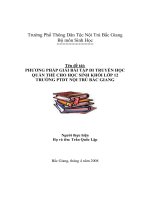Bài giảng sinh vật học quần thể Population
Bạn đang xem bản rút gọn của tài liệu. Xem và tải ngay bản đầy đủ của tài liệu tại đây (1.1 MB, 38 trang )
LOGO
“ Add your company slogan ”
Chapter 3
Populations
Chapter 3. Populations
1. Definition and concepts
2. Properties of populations
•
Population size and density
•
Spatial structure
•
Age structure
•
Sex ratios and reproductive structure
3. Interactions of individuals within a population
•
Negative interactions
•
Positive interactions
DEFINITION
is a group of individuals of the same species that inhabit a given area.
POPULATION CONCEPS
Monomorphic species:
Narrow distribution area,
Relatively
homogeneous
environmental living condition
Only one population
Usually endemic species, easily
be exterminated
Be preserved
Cá cóc Tam Đảo
(Paramesotriton deloustali)
POPULATION CONCEPS
Polymorphic species:
Wide distribution area,
Unhomogeneous
living condition
environmental
All populations adapt to each local
living condition.
Set up new ecological
physiological characteristics.
May have different
originate new species.
Shellfish: Cepaea nemoralis
and
genetics,
POPULATION SIZE
(usually denoted N)
is the number of
individual organisms
in a population.
REVERSE RELATION
Individual size
Individual size is small
Individual size is big
Number of individuals
Many in number of individuals
and low biomass
Few number of individuals
and high biomass
Cá diếc bạc
Tảo xoắn
Spirulina
Vi khuẩn gây
bệnh tả
Chim Se Sẻ Tàu
ROLE OF POPULATION SIZE
Large size
high ability to maintain the life
Population size of the same species in temperate zone is
usually bigger than it’s in low latitude region.
ROLE OF POPULATION SIZE
Minimum number of individuals
Typical characteristic of species
Maintains population’s functions
If the number of individuals of
one population is lower than
minimum number
this
Maximum number of individuals
Is affected by environmental
factors
The maximum number (K) is
equal to environmental capacity.
population will be perished.
Cá Cháy
Cá Mòi
EQUATION OF POPULATION SIZE
Nt +1 = Nt + B – D + I – E
Number of birth and immigration
Births
nhập cư
Population size
Number of death and emigration
chết
POPULATION DENSITY
The number of individuals per unit area (per square kilometer,
hectare, or square meter) or per unit volume (per liter or m3)
Số lượng
Density of Cyprinus carpio
(fish) per 1m3 of water
Khối lượng
400
350
300
250
200
150
100
50
0
Ấu trùng Cá con trọng Cá 1 tuổi
Cá 2 tuổi
trọng lượng
lượng 2g
trọng lượng trọng lượng
25mg
20g
280g
MEANINGS OF DENSITY
Showing the balance between reproductive potential and
environmental capacity.
Affecting the impacts of dependent-density factors
Being the biological signal
Exposing the average distance between individuals and
controlling function activities and physiological status of
individuals in population.
DENSITY MEASUREMENTS
microorganisms
Active animals (fish, reptile,
amphibian, bird, mammal)
Máy đếm Khuẩn lạc
Bò sát
Phytoplankton and Zooplankton
Lưới lấy mẫu TV
nổi
Phytobenthos and
Movement population (determined
population size)
Hard to see population
(dangerous animals).
zoobenthos
ĐV đáy
Hổ
SPATIAL STRUCTURE OF POPULATION
Patterns of the spatial distribution for individuals
within a population
Assemblage, safety area and Allee effect
Isolation and territoriality
PATTERNS OF THE SPATIAL DISTRIBUTION FOR
INDIVIDUALS WITHIN A POPULATION
Uniform
Random
Clumped
UNIFORM DISTRIBUTION
● Homogeneous environmental conditions
● Strong spatial competition between individuals
● Each individual has high territorial property (territoriality)
RANDOM DISTRIBUTION
● Homogeneous environmental conditions
● Individuals have not high territoriality as well as do not tend to
occur in groups.
CLUMPED DISTRIBUTION
● Unhomogeneous environmental conditions
● Individuals occur in groups for searching food,
withstanding enemy attacks…
ASSEMBLAGE
Partial deferences of environmetal factors
Influence of weather factors following the cycle of day-nights and
seasons.
Reproductive process and behavior of species
Social assemblage behavior of some species
Mối và
tập tính xã hội
/>
SAFETY AREA
The special assemblage, each individual group
resides in most favourable centre, spreads out
for food or satisfies other demands, then returns
to centre area.
ALLEE EFFECT
The mechanism of population regulation upon density
Birth rate
Death rate
“Allee effect” and the trend of
increasing and decreasing the
individual’s number within a population
(Theo Begon và Mortimer, 1988)
(a)
0
(b)
U
(c)
K
Population size
ISOLATION
The separation of living space among individuals
• Food competition
• Nest competition
• Breeding competition
•
Food resources competition for newborns
TERRITORIALITY
The regulation mechanism of using habitat and living resources
xây tổ
AGE STRUCTURE
The number or proportion of individuals
in different age classes
Physiological
age
Ecological
age
AGE STRUCTURE
Populations can be divided into three ecologically
important age classes or stage:
Prereproductive
Reproductive
Postreproductive









